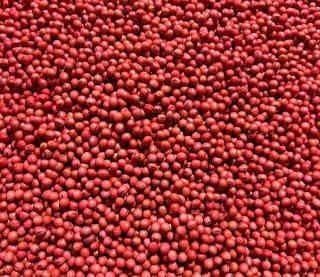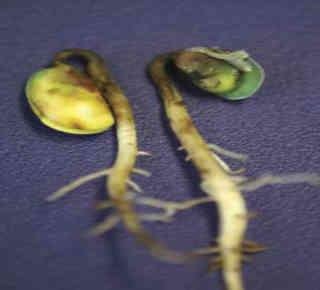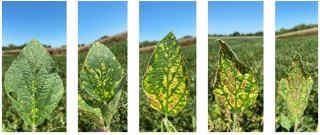By Rodrigo Onofre
As producers start planting soybeans in Kansas, it is important to consider common causes of seedling damping off and potential management strategies. This article addresses some frequently asked questions concerning the use of seed treatments.

What causes poor soybean stand establishment?
Although a few diseases may cause poor stand establishment, it is important to also consider other factors that may be causing it, including herbicide damage, soil compaction, high residue, flooding, cold stress, drought, planting depth, and seed quality. Proper identification of the cause of poor stand establishment will be crucial for current and future management decisions.
What are the main soybean seedling diseases in Kansas and what seed treatments are effective?
The most common pathogens causing seedling diseases in Kansas are: Phytophthora, Pythium, Fusarium, and Rhizoctonia. Although they have different names, the symptoms can be similar. Each of these may result in post-emergence damping off (Figure 1). Although there are seed treatments that are effective against each of these diseases, it is important to remember that these species often require different fungicide products. It is important to carefully check the label of seed treatments and to select a seed treatment product with multiple active ingredients that have efficacy against these common pathogens.
For example, if Phytophthora and Pythium have been a problem in the past, products should be selected with the active ingredients mefenoxam, metalaxyl, or ethoboxam. For Rhizoctonia, the active ingredient sedaxane has shown excellent efficacy. Strobilurin active ingredients such as azoxystrobin, trifloxystrobin, or pyraclostrobin are effective against other fungal pathogens.

Figure 1. Characteristic symptoms of Pythium damping off. Photo from Kiersten Wise, University of Kentucky.
Seed treatments are not the only tool in the toolbox for managing seedling diseases. Variety selection, crop rotation, high seed quality, proper drainage, and seed treatments all make up the best management practices for seedling diseases in Kansas. A combination of these factors will help ensure a high-quality soybean stand.
What conditions favor seedling diseases?
Each disease has slightly different environmental requirements, but seedling diseases are generally favored by planting in cool soil with poor drainage. Spotty occurrences of infected plants may be most pronounced in low or poorly drained portions of the field. When soil temperatures are cool, soybeans planted early should always consider a seed treatment to avoid early-season losses.
Are there any other diseases to consider when using seed treatments?
Seed treatments are not only effective against the pathogens that cause early-season emergence problems. Two products on the market, ILEVO®, and SALTRO™, also provide protection against sudden death syndrome (Figure 2) and soybean cyst nematode. These products should be considered for fields with a previous history of either of these diseases.
To know if soybean cyst nematode is a problem in your field, take advantage of the soybean cyst nematode testing program offered by K-State Research and Extension. Contact your local extension agent for more sample submission information.

Figure 2. Classic soybean sudden death syndrome foliar symptoms development. Infection typically occurs early in the season, but foliar leaf scorch symptoms are most visible at reproductive growth stages. Photos by Rodrigo Borba Onofre, K-State Research and Extension.
Source : ksu.edu